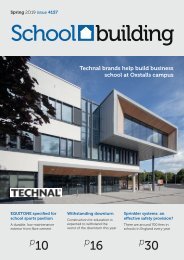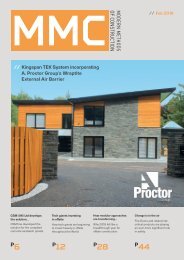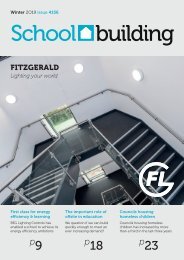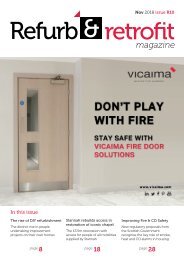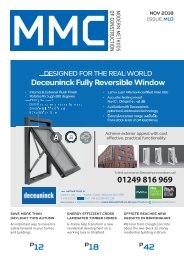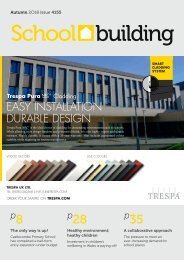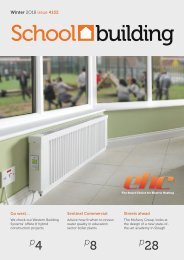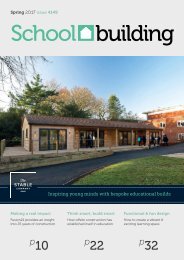February Refurb and Renew magazine
Create successful ePaper yourself
Turn your PDF publications into a flip-book with our unique Google optimized e-Paper software.
Building Envelope |<br />
<strong>Refurb</strong>s offer flexible opportunities<br />
to focus on fabric to meet Part L<br />
Successive revisions to Part L of the Building Regulations have raised the bar on energy efficiency for refurbishment projects. Such<br />
schemes present an opportunity to focus on improvements to the building fabric which mitigate the need to incorporate renewable<br />
technologies, <strong>and</strong> which can be more straightforward to achieve than in new builds. Graham Suttill, Energy Assessor at Darren Evans<br />
Assessments reports.<br />
Graham<br />
Suttill<br />
Aircrete wall<br />
with brickwork<br />
22<br />
The revision to Part L of the Building Regulations<br />
in 2013 raised the bar for the industry<br />
significantly, requiring an additional 6%<br />
improvement required on CO2 emissions over<br />
that required by 2010 Part L. However for<br />
domestic refurbishment projects there is no<br />
Building Regulation requirement to meet the<br />
Target Emission Rate (TER) which is required for<br />
new builds, although depending on the Part L1B<br />
route to compliance followed the emissions can<br />
play an important role.<br />
The most straightforward way to achieve Part L1B<br />
compliance is to meet the U-value requirements<br />
for retained <strong>and</strong> new thermal elements of the<br />
dwelling. The U-values for new thermal elements<br />
under Part L1B are in line with the requirements<br />
for a new build house with the exception of the<br />
external wall which requires a slight improvement<br />
under L1B.<br />
The retained thermal elements are slightly<br />
different, having a ‘threshold’ U-value. If the<br />
element U-value is below that of the threshold<br />
before any work begins, then improvement is not<br />
required. However if the retained element is<br />
above the threshold the thermal efficiency must<br />
refurb| RENEW Jan / Feb 2O16 issue 8955<br />
be improved. The improved U-values required are<br />
again almost in line with new build st<strong>and</strong>ards with<br />
the exception of cavity walls where a target U-<br />
value of 0.55 is required; this can normally be<br />
achieved through retrofitting blown cavity<br />
insulation.<br />
The challenge in meeting the target U-values can<br />
arise in the refurbishment of historic buildings. A<br />
common issue that arises is the solid walls of<br />
these period buildings should be insulated to<br />
achieve a U value of 0.30 - typically achieved with<br />
60mm+ insulated plasterboard. Where original<br />
features are required to be retained this is not an<br />
option. In this instance there are two options<br />
available: a 15 year payback calculation or a<br />
notional <strong>and</strong> proposed SAP calculation. The<br />
payback calculation involves a feasibility study to<br />
see if cost savings from the proposed measure<br />
would cover the cost of purchase <strong>and</strong> installation<br />
within 15 years.<br />
The second <strong>and</strong> most preferred option in our<br />
experience is to provide a notional <strong>and</strong> proposed<br />
calculation to demonstrate a CO2 reduction is<br />
being achieved. The notional calculation is of a<br />
Building Regulations-compliant dwelling which is<br />
modelled in SAP with the CO2 emissions<br />
calculated. Then the proposed dwelling is<br />
calculated which might for example have an<br />
external wall U-value which is failing Part L but<br />
other improvements elsewhere which go beyond<br />
the Building Regulations st<strong>and</strong>ard, for example<br />
improved heating efficiencies or controls. If the<br />
CO2 emissions are less on the proposed<br />
calculation than the notional, the building passes<br />
Part L. In effect, this allows the extra CO2<br />
emissions from a failing element to be offset<br />
elsewhere in the calculation.<br />
In addition to the targets on U-values for the<br />
building fabric which are required to be met by<br />
for Part L when undertaking a refurbishment,<br />
there are also minimum efficiencies required for<br />
heating systems <strong>and</strong> certain st<strong>and</strong>ards for heating<br />
controls. These are outlined in the Government’s<br />
Domestic Building Services Compliance Guide.<br />
In essence it is much easier to achieve<br />
compliance for a refurbishment than a new build<br />
property, primarily due to the lack of CO2<br />
emissions targets but also the degree of flexibility<br />
in offsetting emissions that Part L1B allows.<br />
www.darren-evans.co.uk



